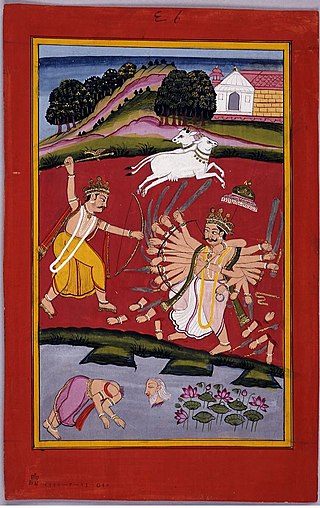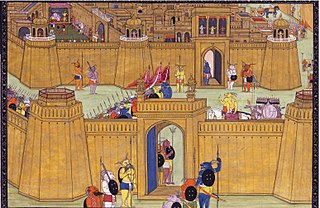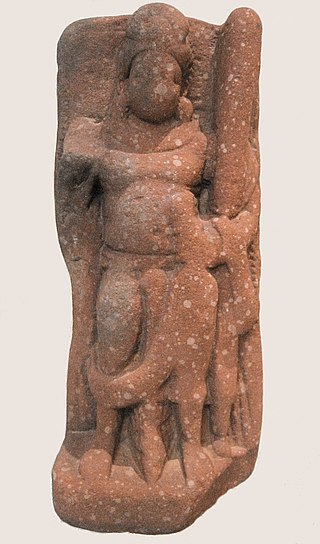Related Research Articles

Jamadagni is a sage in Hindu literature. He is regarded in Hindu tradition to be one of the Saptarishi in the 7th, and the current age of Manvantara.

Kubera also known as Kuvera, Kuber and Kuberan, is the god of wealth, and the god-king of the semi-divine yakshas in Hinduism. He is regarded as the regent of the north (Dikpala), and a protector of the world (Lokapala). His many epithets extol him as the overlord of numerous semi-divine species, and the owner of the treasures of the world. Kubera is often depicted with a plump body, adorned with jewels, and carrying a money-pot and a club.

Lanka is the name given in Hindu epics to the island fortress capital of the legendary asura king Ravana in the epics of the Ramayana and the Mahabharata. The fortress was situated on a plateau between three mountain peaks known as the Trikuta Mountains. The ancient city of Lankapura is said to have been burnt down by Hanuman. After its king, Ravana was killed by Rama with the help of Ravana's brother Vibhishana, the latter was crowned king of Lankapura. His descendants were said to still rule the kingdom during the period of the Pandavas. According to the Mahabharata, the Pandava Sahadeva visited this kingdom during his southern military campaign for the rajasuya of Yudhishthira. The palaces of Ravana were said to be guarded by four-tusked elephants.
Manu is a term found with various meanings in Hinduism. In early texts, it refers to the archetypal man, or to the first man. The Sanskrit term for 'human', मनुष्य or मानव means 'of Manu' or 'children of Manu'. In later texts, Manu is the title or name of fourteen rulers of earth, or alternatively as the head of dynasties that begin with each cyclic kalpa (aeon) when the universe is born anew. The title of the text Manusmriti uses this term as a prefix, but refers to the first Manu – Svayambhuva, the spiritual son of Brahma. In the Hindu cosmology, each kalpa consists of fourteen Manvantaras, and each Manvantara is headed by a different Manu. The current universe, is asserted to be ruled by the 7th Manu named Vaivasvata. Vaivasvata was the king of Dravida before the great flood. He was warned of the flood by the Matsya (fish) avatar of Vishnu, and built a boat that carried the Vedas, Manu's family and the seven sages to safety, helped by Matsya. The tale is repeated with variations in other texts, including the Mahabharata and a few other Puranas. It is similar to other floods such as those associated with Gilgamesh and Noah.
The Chinas are a people mentioned in ancient Indian literature, such as the Mahabharata, Manusmriti, and the Puranic literature.

The kingdom of Tushara, according to ancient Indian literature, such as the epic Mahabharata, was a land located beyond north-west India. In the Mahabharata, its inhabitants, known as the Tusharas, are depicted as mlechchas ("barbarians") and fierce warriors.
Sakas are described in Sanskrit sources as a Mleccha tribe grouped along with the Yavanas, Tusharas and Barbaras. There were a group of Sakas called Apa Sakas meaning water dwelling Sakas, probably living around some lake in central Asian steppes. Sakas took part in Kurukshetra War.
Rishika was an ancient kingdom inhabited by the Rishikas who were originally a tribe north to Himalayas who had limited interaction with early Indian kingdoms and mentioned in the epic Mahabharata. They belonged to the Xinjiang province of China, east of Kashmir. The Pandava hero, Arjuna visited this place during his northern military campaign for collecting tribute for Yudhishthira's Rajasuya sacrifice.
The Keralas or Udra Keralas were a royal dynasty mentioned in Sanskrit epics of ancient India. In the Mahabharata, the Keralian empire took part in the Kurukshetra War by feeding both armies. According to the Puranas, the navigators and survivors of the Yadavas of Dwaraka also settled in Kerala later. Some remnants of the Naga culture are also found here.

The Kirāta is a generic term in Sanskrit literature for people who had territory in the mountains, particularly in the Himalayas and Northeast India and who are believed to have been Sino-Tibetan in origin.
Rakshasa kingdom refers to the territory of Rakshasas who were a tribe, mentioned along with others like Devas, Asuras, Pisachas, Gandharvas, Kimpurushas, Vanaras, Suparnas, Kinnaras, Bhutas and Yakshas. Rakshasas were described to have large bodies, probably due to their continuous life in cold climates over snow-covered mountains. The forefathers of the famous Rakshasa king Ravana lived along with the Yakshas. The Yaksha king Kubera was the elder brother of Rakshasa king Ravana. Ravana had many sons among Gandharva wives. The two epics Mahabharata and Ramayana and many Puranas attest that Rakshasas, Yakshas and Gandharvas were related and had inter-marriages.

The Yaksha kingdom refers to the mythological kingdom of the yakshas, a race featured in Hinduism. Kubera is referred to as the king of the Yakshas.

Kirata kingdom in Sanskrit literature and Hindu mythology refers to any kingdom of the Kiratis, who were dwellers mostly in the Himalayas. They took part in the Kurukshetra War along with Parvatas (mountaineers) and other Himalayan tribes.

The Himalaya kingdom was a mountainous country in the Himalayas, mentioned in the Puranas. In the puranas, Himavat was its ruler and his daughter Parvati was a princess from this kingdom. The Indian epic Mahabharata doesn't mention a kingdom named Himalaya, but mentions many kingdoms in the Himalaya mountains like the Kuninda, Parvata, Nepa, Kirata, Kimpurusha, and Kinnara.
Parvata Kingdom refers to the territory of a tribe known as Parvatas (Mountaineers), mentioned in the epic Mahabharata. Most of the descriptions of Parvata kingdom in the epic refer to a mountainous country in the Himalayas. Tribes belonging to other mountainous regions in the north west, west and the east of the Indo-Gangetic Plain were also known as Parvatas, when used as a collective name. Parvatas took part in the Kurukshetra War. The epic also mentions a sage named Parvata who was a companion of sage Narada.

The Bahlikas were the inhabitants of a location called Bahlika, mentioned in the Atharvaveda, Mahabharata, Ramayana, Puranas, Vartikka of Katyayana, Brhatsamhita, Amarkosha, and other ancient inscriptions. Other variations of Bahlika include Bahli, Balhika, Vahlika, Valhika, Bahlava, Bahlam/Bahlim, Bahlayana, and Bahluva.
Kampil, historically known as Kampilya, is a town and a Nagar panchayat in Farrukhabad district in the Indian state of Uttar Pradesh. It is located about 45 km from Farrukhabad, and 55 km from Budaun. It is a very important place from a historical point of view.

Yalamber or Yalung, Yalambar, Yalamwar, Yalamver was a Kirati warrior and first King of Kirata Kingdom in Nepal. He established Kirata Kingdom in 800 B.C. His capital was Yalakhom, present day Kathmandu Valley (Thankot) after conquering Central Nepal and his kingdom extended from river Trishuli in the west to river Teesta in the east of Bhutan. Patan also known as is resemblance to Yalamber as he ruled the regions.
Pulaha is a character in Hindu mythology. He is the son of Brahma, the creator god, and also one of the Saptarshi, in the first Manvantara, with others being Marichi, Atri, Angiras, Kratu, Pulastya, and Vasishtha. In another classification, Pulaha is one of the ten Prajapatis, the progenitors of creation created by Brahma. The race of the kimpurushas are the children of Pulaha, according to the Mahabharata.
References
- Mahabharata of Krishna Dwaipayana Vyasa, translated to English by Kisari Mohan Ganguli